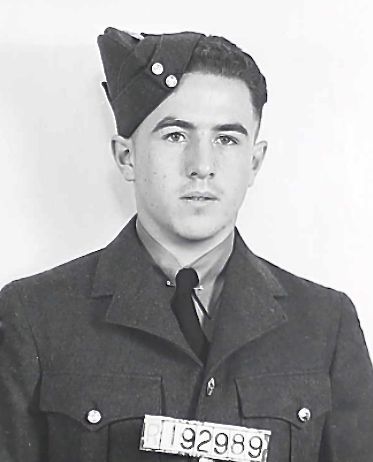

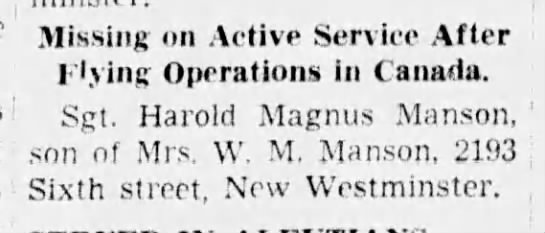
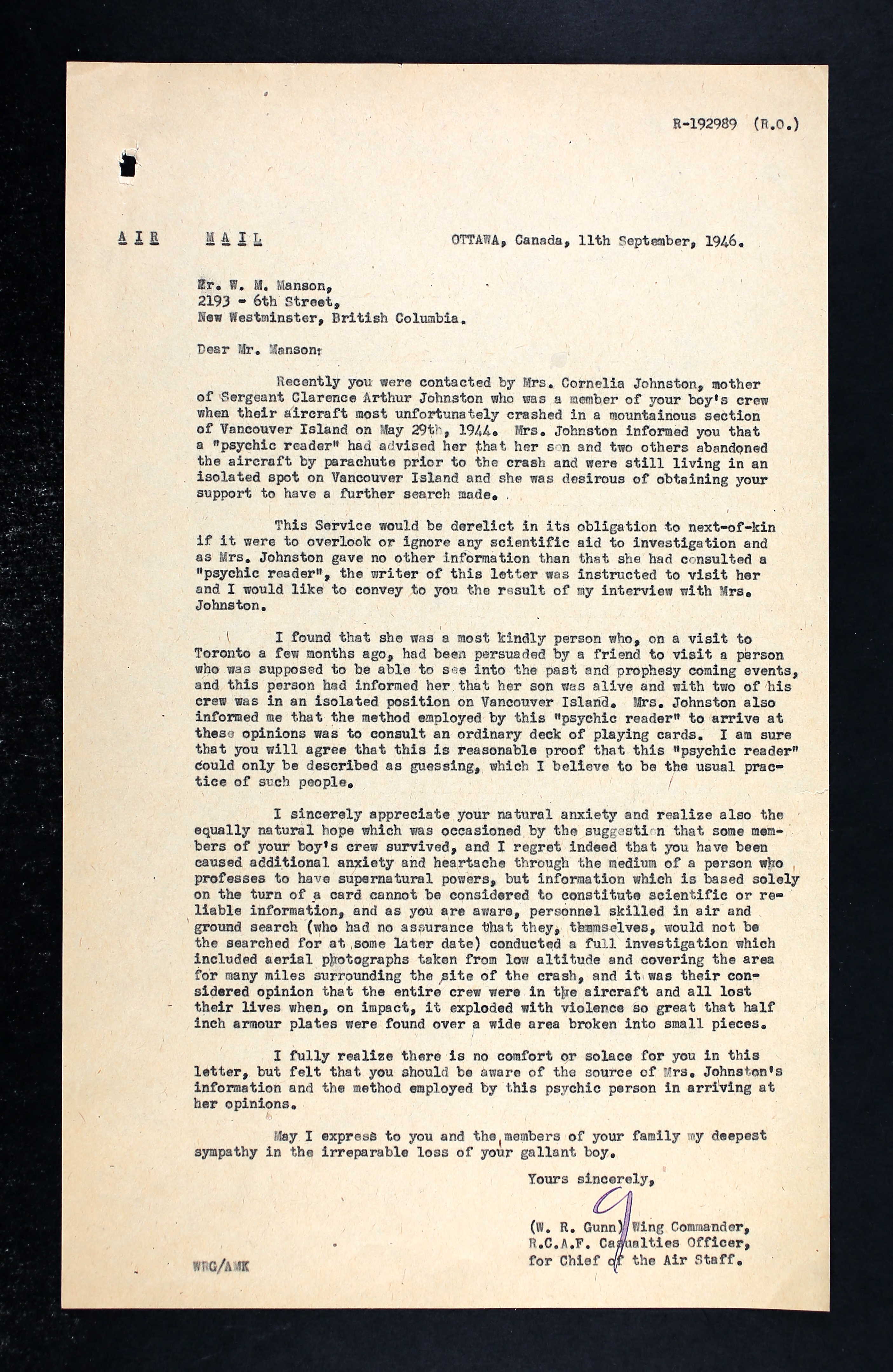
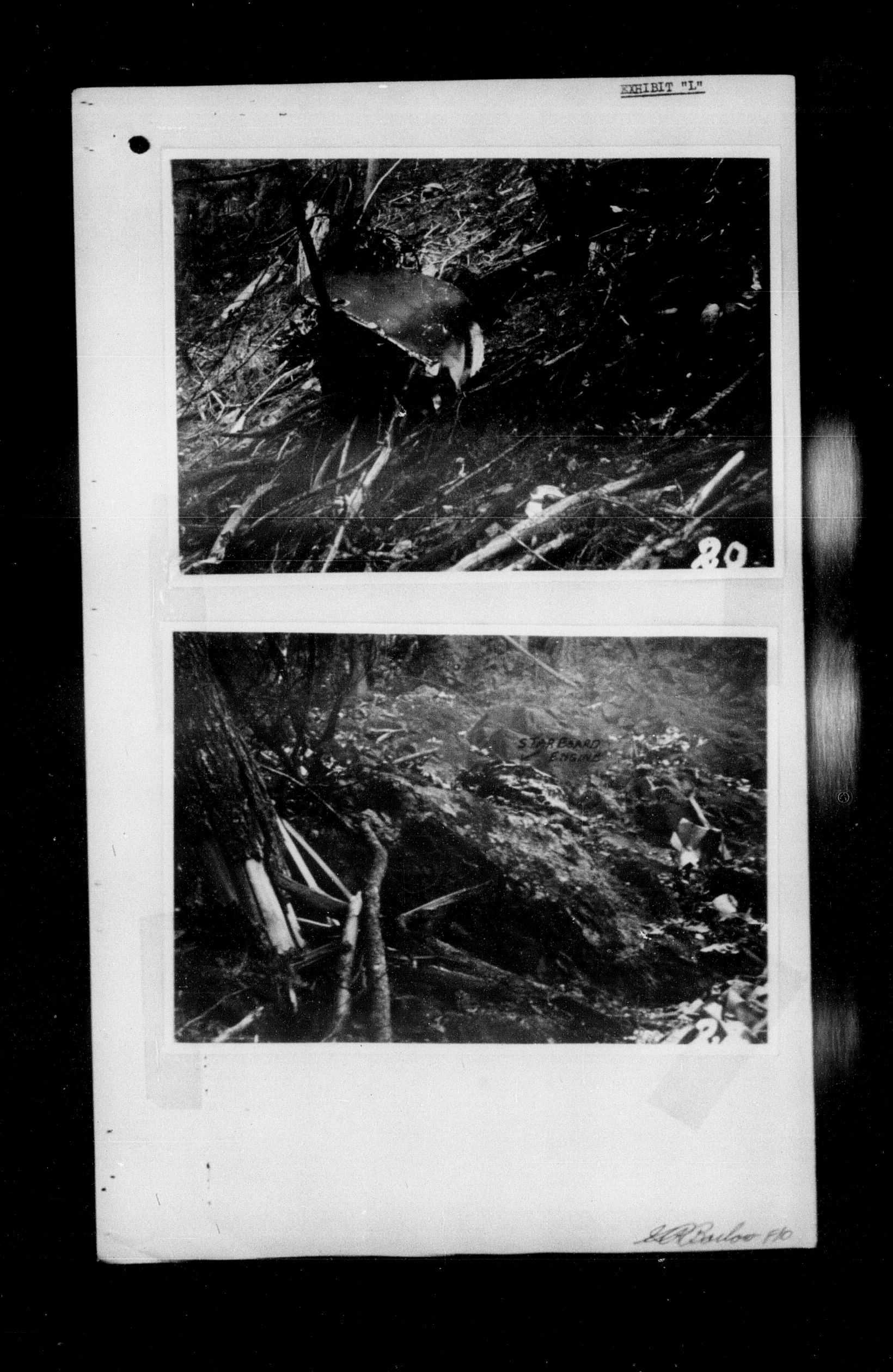
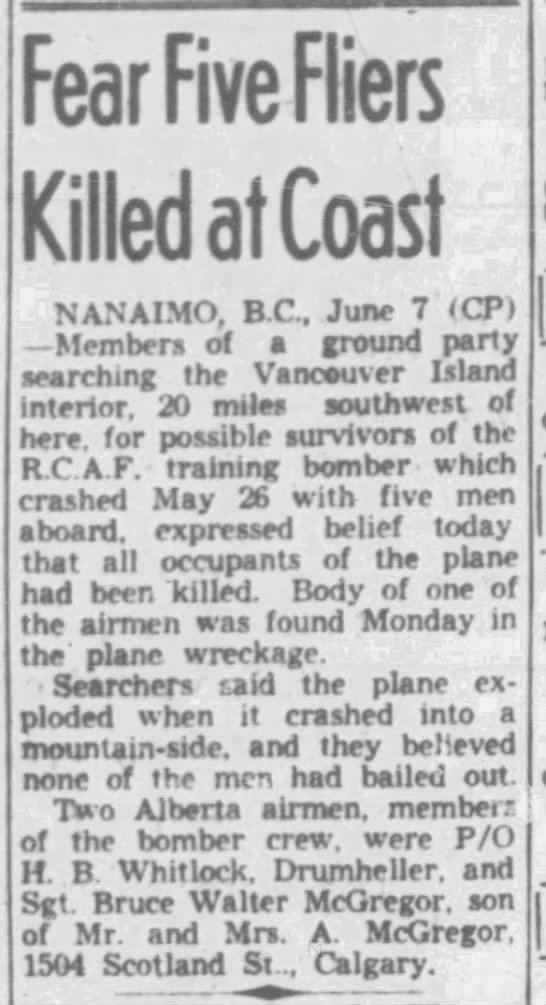
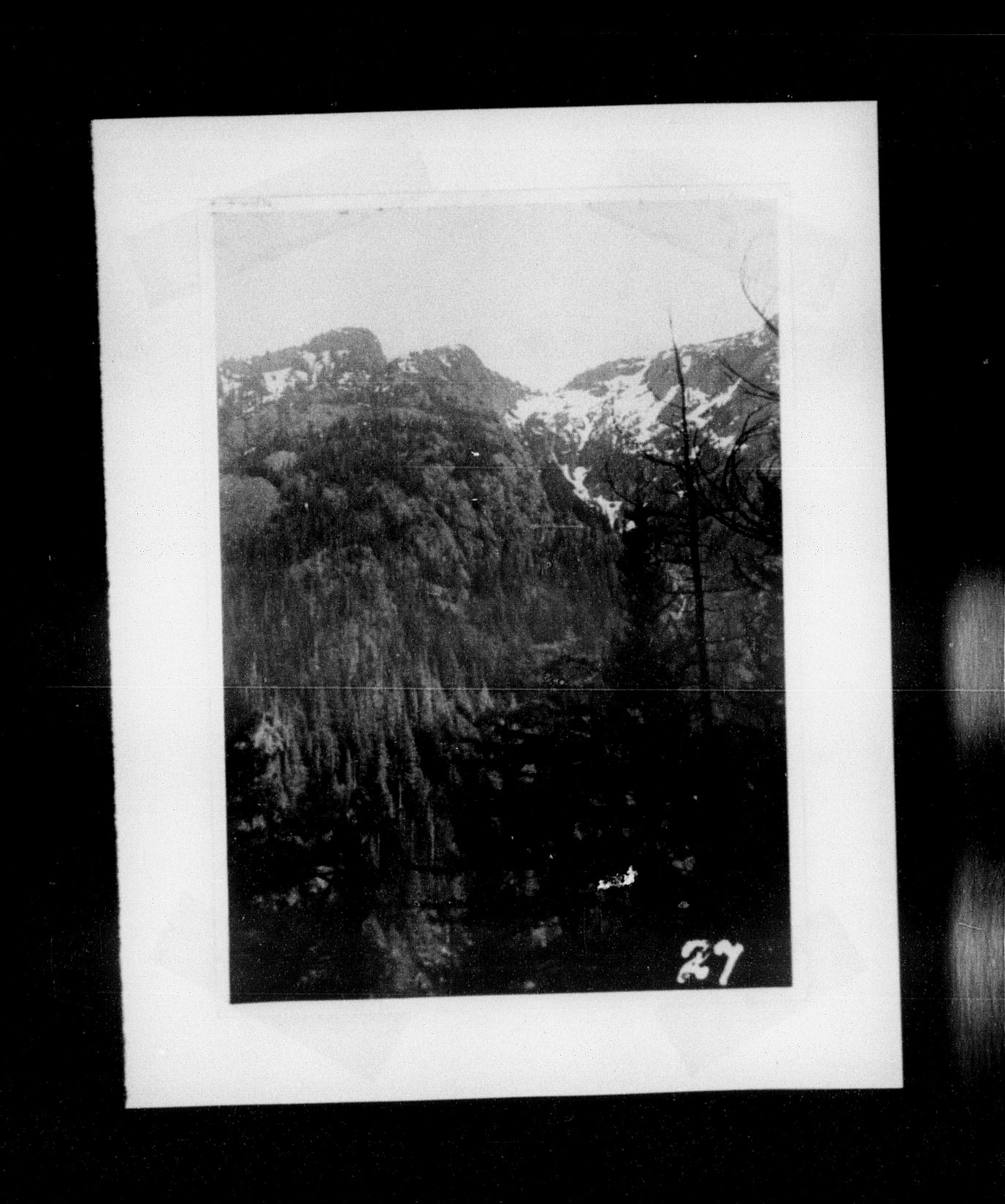
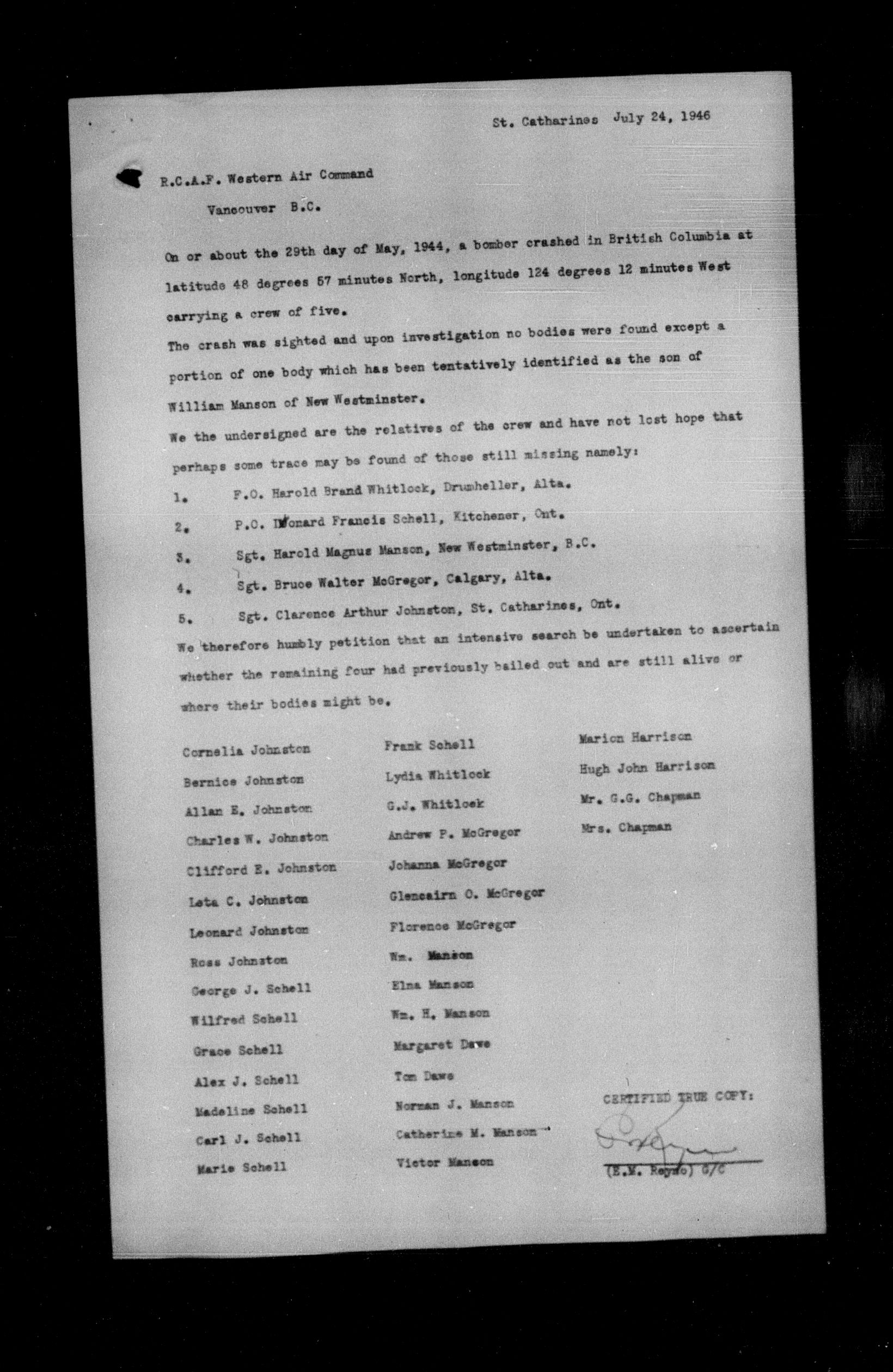
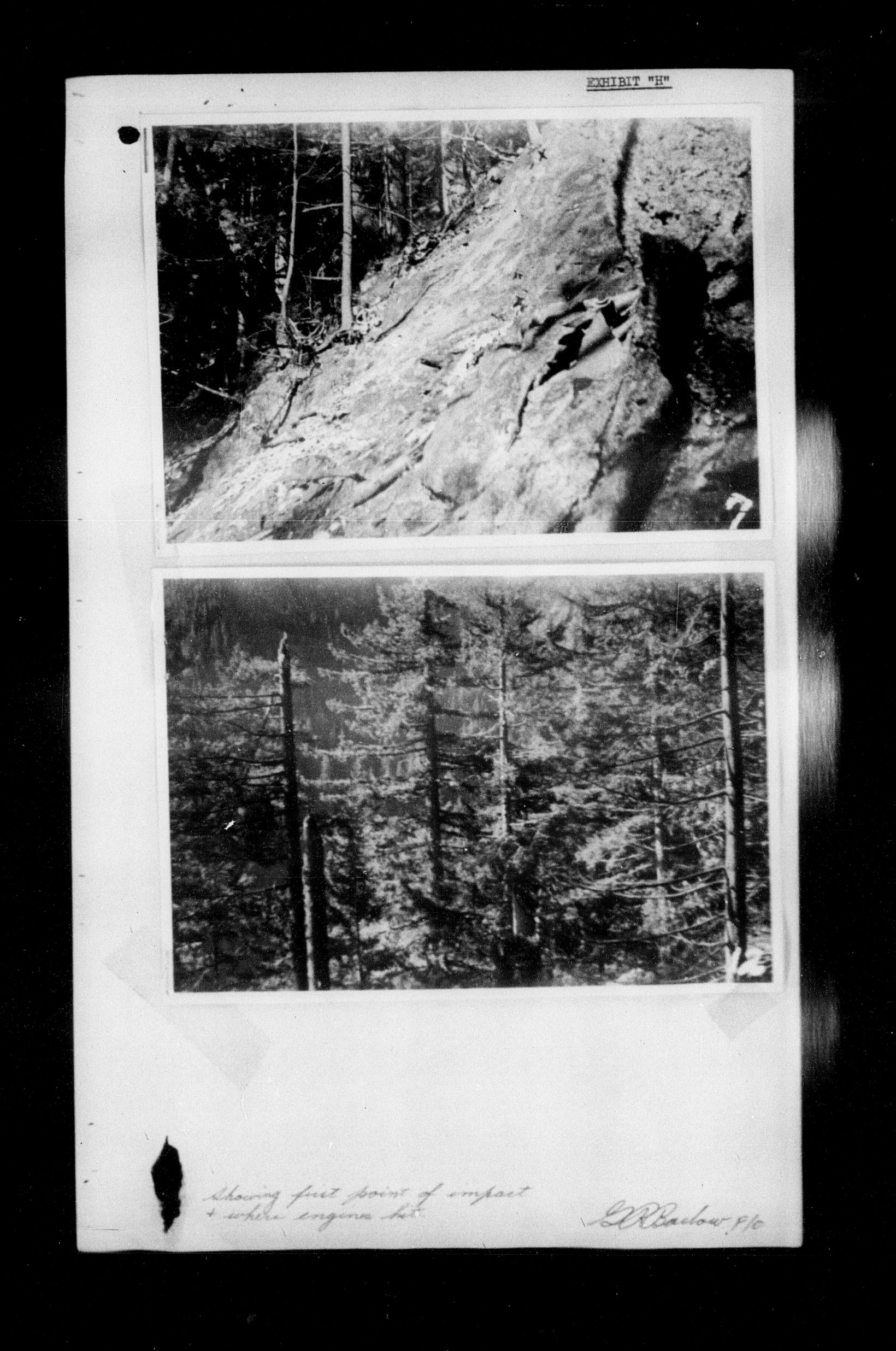
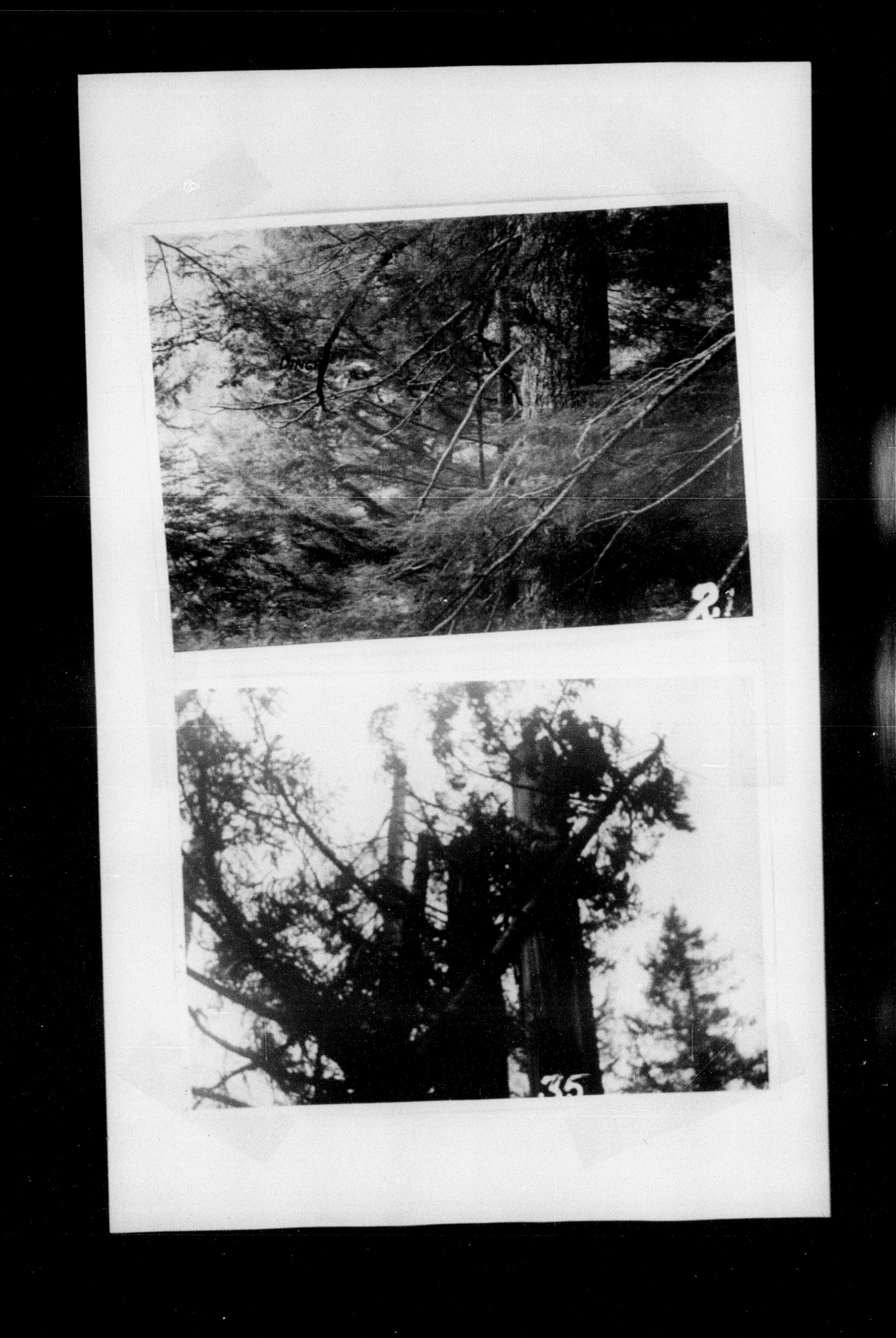
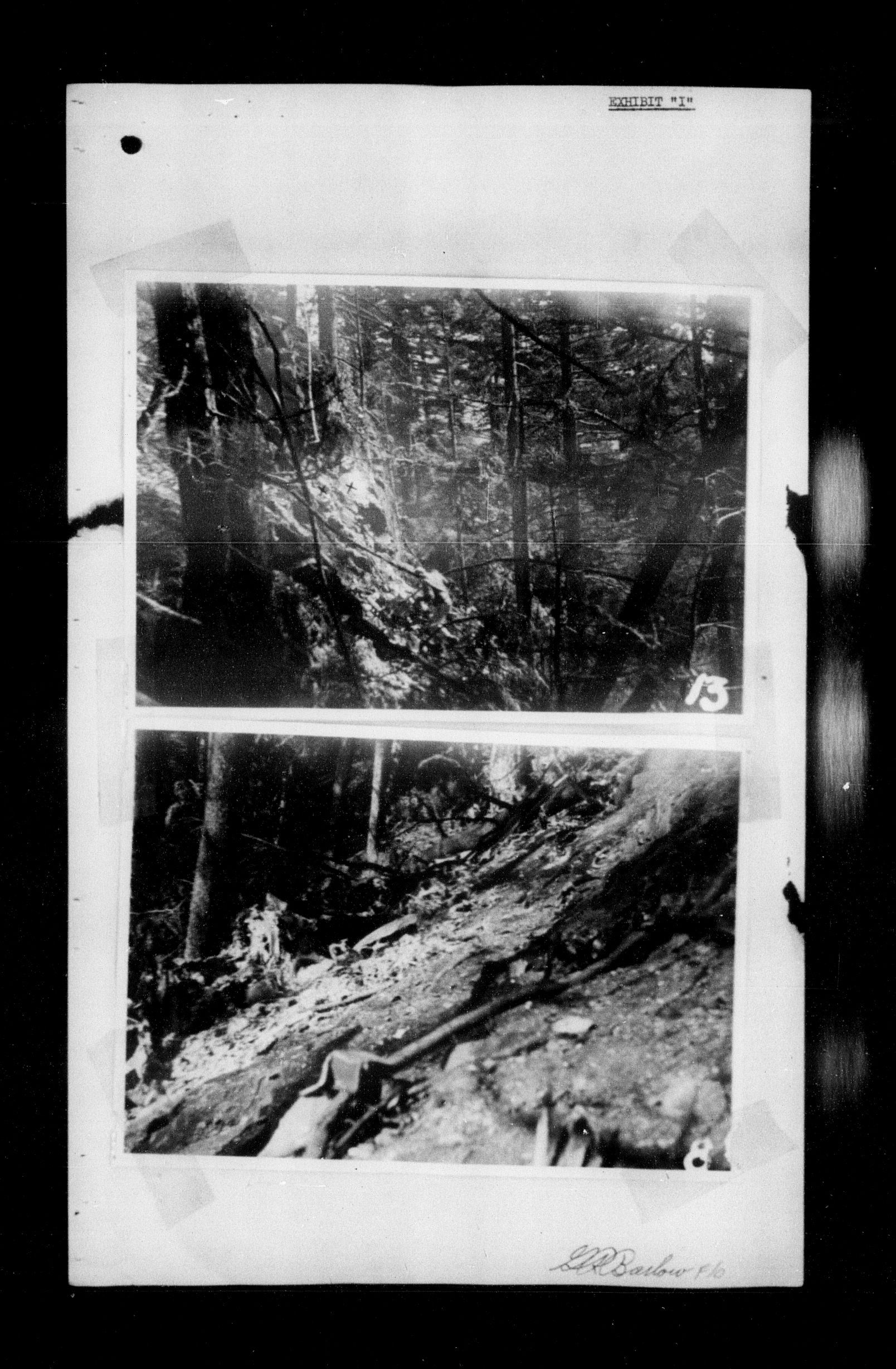
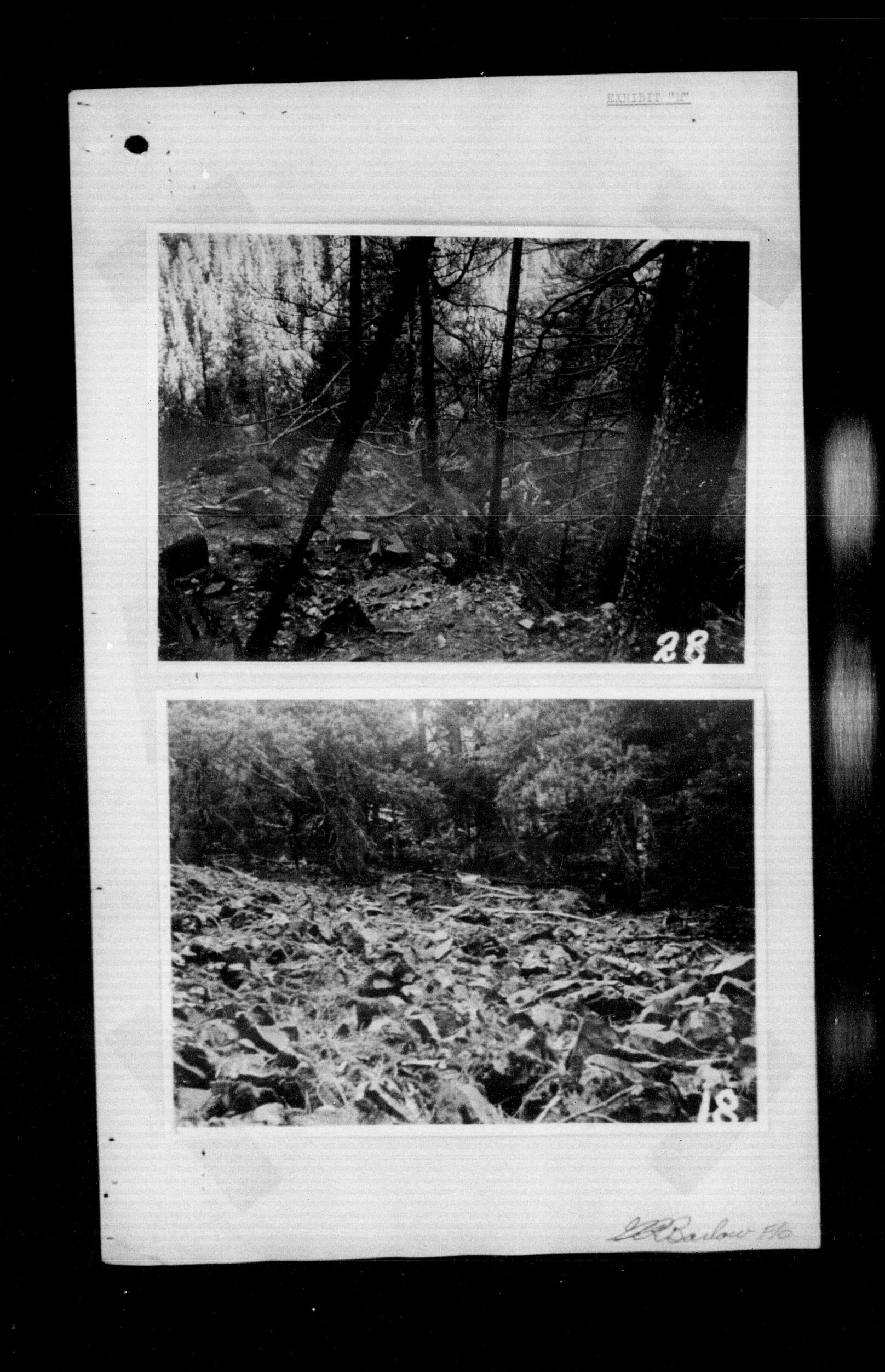
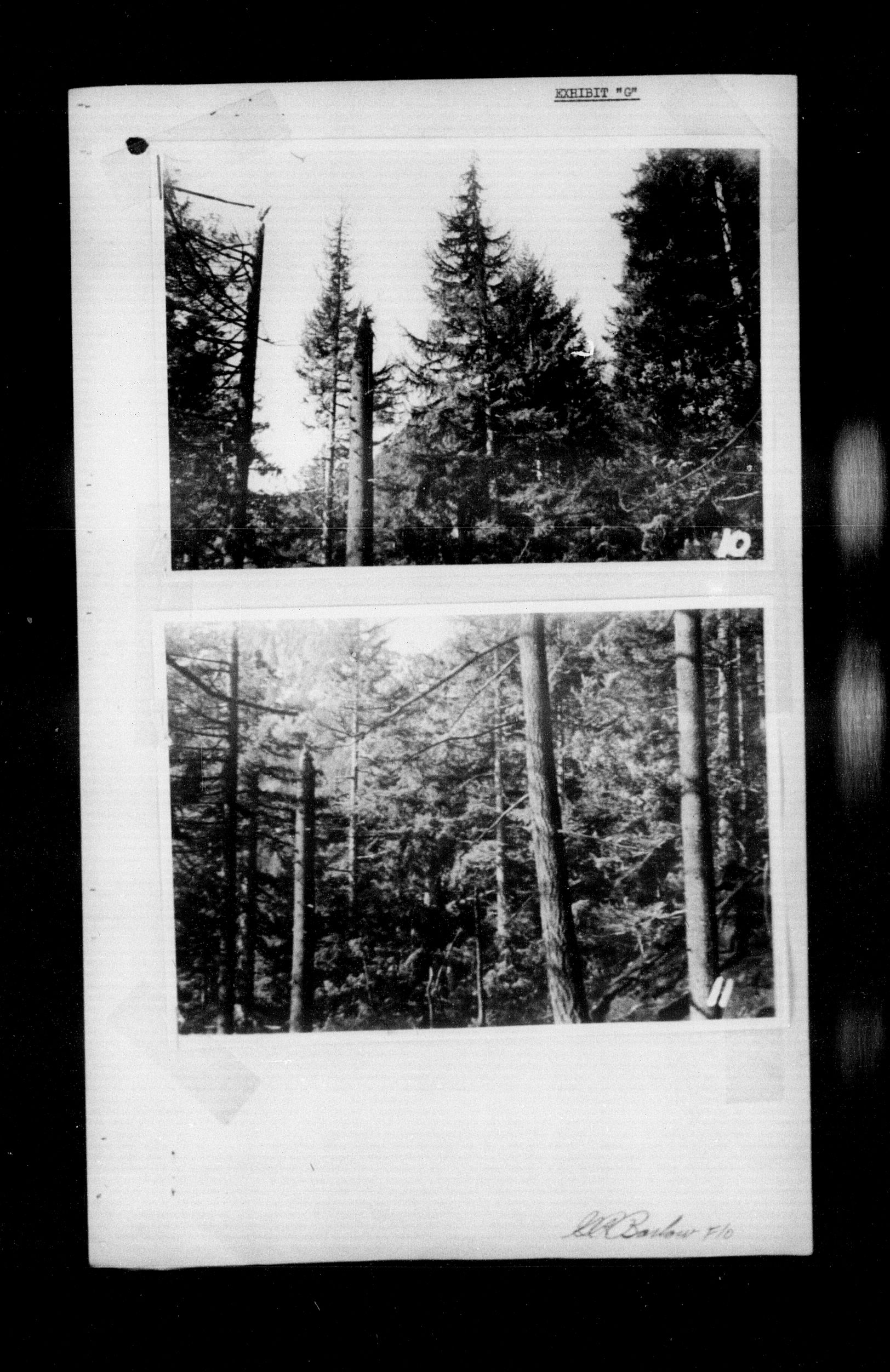
August 25, 1923 - May 29, 1944













Harald Magnus Manson was the son of William Magnus Manson (1883-1952), engineer, and Elna Alice (nee Backlund) Manson (1888-1968) of New Westminster, BC. He had three brothers and two sisters: William Herman, Victor Gilbert, Norman James, Mrs. Margaret Alice Dawe, and Mrs. Elna Marion Harrison. The family was Presbyterian.
He was a blacksmith apprentice for one year, a member of Drop Forgers & Helpers. He worked for the CNR Railway for 14 months as a blacksmith’s apprentice prior to enlisting with the RCAF in October 1942. He had his appendix removed on July 26, 1942. That scar and another on the centre of his forehead above right eyebrow were noted. He liked to play basketball and softball. “Athletic. Alert.” He stood 5’7” tall and weighed 150 pounds. “Fit. Keen, young, stable. Good pilot and navigator material. Aggressive lad. Anxious to be pilot. Should prove a good pupil.”
Harald was at No. 3 Manning Dept in Edmonton, then was sent to No. 4 ITS, March 8 to May 14, 1943, where he earned 74%. “Was in Sea Cadets. Normal sports. Quiet, serious, average intelligence, slightly nervous, pleasant, good type. Alternative: Air Bomber.” He was sent to No. 5 EFTS, High River, Alberta from May 17 to July 9, 1943. Here he earned 66%. “This airman failed to pass final Ground School exams. Honest and sincere, desires to remain in aircrew as WAG. A good type of airman who should do well.”
Harald was at No. 3 Wireless School, Winnipeg, Manitoba, August 8, 1943 until February 25, 1944, 76th out of 100. He was authorized to wear Wireless Badge February 25, 1944. He was then posted to No. 5 B&G School in Dafoe, Saskatchewan. “Course leader at B&G. Reliable steady type. Well-liked by class and by instructors. Displays both self-confidence and initiative. Above average, a good trainee. Handles men well.” April 6, 1944. He was considered to be definitely suitable to be a gunnery instructor.
He was admitted to Deer Lodge Hospital August 30 until September 3, 1943, then again in hospital August 27 to October 6, 1943.
Harald’s General Conduct Sheet noted three offences: August 5, 1943: absent from 1315 hours parade, 7 days confined to barracks; September 5, 1943: WOAS is charged with gambling in barracks, 72 hours detention, forfeits three days’ pay; December 11, 1943: absenting himself from classroom without permission, 48 hours detention and forfeits two days’ pay.
Harald was taken on strength at No. 5 O.T.U. Boundary Bay, April 22, 1944.
Mitchell HD345 [Court of Inquiry: C-5938 Image 206]. CREW: F/O Harold Brand Whitlock, J28562, P/O Leonard Francis Schell, J43902, Sgt. Harald Magnus Manson, R192989, Sgt. Bruce Walter McGregor, R267192, and Sgt. Clarence Arthur Johnston, R275157. On May 29, 1944, they had been involved in a cross-country exercise. All five men were buried at the crash site “in a heavily wooded area” on a mountainside near Mount Whymper in the Cowichan Valley, on Vancouver Island.
A US Navy blimp was involved in the search. It crashed. The balance outstanding for accounts rendered but unpaid amounted to $1,004,804.61 according to a letter sent to the Canadian Government from the US Navy.
The Court of Inquiry was opened on May 31, 1944, at No. 5 O.T.U. Boundary Bay, BC. Fifteen witnesses were called. P/O Whitlock, pilot, had experience on Tiger Moth, Anson, Harvard, Ventura and Mitchell aircraft.
The first witness, S/L J. L. Snider, J15257, CFI, RCAF Station, Boundary Bay, BC stated, “On 29 May 1944, at 1330 hours, I briefed the crew of aircraft Mitchell HD345. The exercise authorized for this flight was No. 102….to Gordon Head and run to bombing range and then to base…The briefing consisted of instruction by myself, navigation officer, signals officer, gunnery officer, flying control officer and met officer. My instructions for this exercise where to set course over base at 2000 feet and climb on the first leg to 10,000 feet. The remainder of the exercise was to be carried out at 10,000 feet. I told the captains to fly at a higher altitude if they encountered cloud at 10,000 feet. From the met report, clouds appeared to be from 9000 to 10,000 feet. Although four aircraft were briefed for this exercise, only three commenced the exercise, one having been declared unserviceable. The other two aircraft which commenced the exercise completed it without difficulty.”
The second witness, S/L William Robert Gray, J4927, Flight Commander of Mitchell Conversion Flight 5 O.T.U. stated that there was no order that he knew of to prohibit pilots on a cross country from doing single engine flying.
The third witness, WO2 Arthur Russell Jones, R121359, navigation instructor stated, “On the first leg, the aircraft were to set course at 2000 feet climbing to 10,000 feet, and check course true by Astro compass, obtain a pinpoint at height and obtain a wind velocity and alter course at height if necessary and revise E. T. A.., check ground speed on first leg at height and get pin upon crossing seaward coast and restart air plot from here. The navigator was to try and get two loop fixes before position A and altering course if necessary. Shortly before E. T. A. was up, they were to take a drift and another drift after altering course for position B and obtain a wind velocity. With this wind velocity, alter course if necessary for position B. Similar instructions were given for each leg. They were to make a D.R. run from position C to Piers Island.”
The fifth witness, F/O J. K. McConnell, assistant gunnery officer stated that he briefed the crews of four Mitchell aircraft on exercise No. 102. “The briefing instructions which I gave the gunners was to practice turret manipulation, search, and report all aircraft to the captain. One gunner is in the turret and the other does map reading in the front and they alternate on different trips.”
The seventh witness, F/L Raymond Gourley McPhie, C7110, Control Officer stated, “Details of my instructions consisted of local traffic pattern and R. T. patter radio aids for this exercise. Their duty was to report when passing over stations within a 25-mile area. The pilot’s responsibility for distress signals emphasizing the necessity to initiate a distress signal as urgently as possible in order to assure position fixing. They informed of their air sea rescue facilities for this exercise.”
The eight witness, P/O William Herbert Kay, J44159, air gunner under instruction, stated, “On the 29th May 1944, I was a member of S/L Stroud’s crew detailed to carry out exercise 102 on Mitchell aircraft 311. The crew of this and other aircraft detailed for the same exercise were fully briefed therefore. Our aircraft carried out the exercise without difficulty. The weather was as forecast except that we encountered the occlusion off the west coast of Vancouver Island somewhat earlier than expected. While in the vicinity of Cowichan Lake on the first leg of our route at about 1500 hours, Vancouver Island, and flying at 10,000 feet from the co-pilot seat where I was observed from three to five miles to starboard another aircraft of which I had but a fleeting glance, which gave me the impression that it was a Mitchell; it was flying at 5000 to 8000 feet in a very shallow dive and while off our starboard beam it made a sharp or abrupt turn through 180 degrees. when last seen, it was headed into a cloud or base of the cloud on an approximate course of 90 degrees. This is all I saw. The aircraft appeared to be in a normal flight but appeared to be traveling fast. It made a very sharp turn. I could not say if the aircraft was running on two engines as I wasn't in a position to notice the engines but at the speed the aircraft was traveling and the sharp turn the pilot made, I would say that it was running on both engines at that time.”
The ninth witness, F/O Reginald Arnold Clarke, RAF129222, pilot under instruction stated, “On the 28th of May 1944, at 1425 hours, I was pilot on Mitchell aircraft HD345 on a 3 hour cross country navigation exercise. During this flight, the flying characteristics of this aircraft were perfectly normal, but the magnetic compass was reading approximately 12 degrees in error when checking with the Astro compass on a westerly and south easterly heading. I reported this error to the flight commander, Squadron Leader Grey, and navigation officer Flight Lieutenant Aeron. On this trip I was requested by the instrument section to check the gyro pilot horizon and found this to be working satisfactory.”
The tenth witness, F/L John Gillespie Slipp, C8539, Station Signals Officer stated, “The subject aircraft at 1440 hours on 29th May 1944, made contact with the ground station and sent its airborne message, his frequency was reported correct, and signals were strength five. At approximately 1448, the aircraft called the ground station and reported that it was changing from the other set to ground frequency. At 1450 hours, the aircraft called on this frequency asking for a signal strength and frequency check, the frequency was correct, and the signals were strength five. At 1507 hours, the operator on duty thought she heard this aircraft calling through the heavy interference. She answered it a number of times but received no reply. Atmospheric and local interference was very strong that day and it is therefore quite probable that this supposed call was not the aircraft in question. In addition to the D.F. Assistance available for exercise 102 named by the 4th witness, there is also available as navigational aids, the RCAF homing beacons, Department of Transport radio range stations, marine beacons, and marine D.F. Stations all of which were known to the operator on the subject aircraft.
The twelfth witness, S/L Lewis Williams Luke, C509, Chief Engineer Officer stated that reason the one Mitchell that was unserviceable and did not go out on the cross-country exercise “was that the pilot washed out the trip when he found the port oil pressure low. This subsequently was shown to be due to a defective oil pressure gauge which was replaced.”
The next set of witnesses involve the search for Mitchell HD345.
The eleventh witness was F/L Gerald Herbert Lee, C8277, Command Air Search and Rescue Officer at WAC, Vancouver, BC. “I was the officer in charge of the party that first searched the scene of the crash of Mitchell 345 on Saturday June 3rd, 1944, at 1500 hours. The aircraft appeared to have spun in at a very steep angle as the break in the trees indicated by the photographs. It appeared to have struck the base of a rock bluff as shown in other photographs. The aircraft exploded with tremendous violence as evidenced by the small pieces of metal that were left and the large area this metal covered. Some parts of metal had been blown 50 yards up the hill onto ledges in the almost vertical Bluffs which went up from the scene of the crash. The destruction was so complete that I thought the plane must have been carrying high explosives but later found out this was not the case. The whole area extending from the scene of the crash to a point 100 yards above it and 100 yards below it had been set on fire for a maximum width of 30 yards. I also produce a photograph showing part of the burnt wreckage which had rolled down a 35 degree slope some 30 feet directly below the point of impact. I also produced a photograph showing a portion of the wingtip which was lying in the unburnt timber some 30 feet below the point of impact and to the left. I also produce a photograph showing the general location of the wreckage and it can be noted that this wreckage is mixed up with rock which it disturbed by the explosion and rolled down the slope. In my opinion, the port propeller had been under power at the time of the crash as evidenced by the nicked and twisted forms of the blades and the tip of one which had cut its way deep into one of the trees broken off by the crashing aircraft. The blades of the starboard propeller were broken but were not nicked or twisted so I thought it was likely that the starboard engine was not operating. It is considered the opinion of the rescue party and myself that an aircraft the size of a Mitchell could not have crashed at this particular spot without making a larger swath through the trees unless part of the aircraft was missing at the moment it crashed.”
The thirteenth witness, F/L Charles Edmond Ducharme, C10172, Engineering Officer III WAC, stated, “On Saturday, June 3, 1944, I arrived at Nanaimo where I picked up the necessary equipment to proceed to the crash. From Nanaimo I proceeded by Jeep to the Nanaimo Dam where the first camp had been established and then proceeded on foot to the advanced camp which was four miles further inland. On Monday, June 5th, 1944, I proceeded on inland with a guide and after a 7-hour trek up the mountain the scene of the crash was reached. The following parts found gave evidence that the aircraft was Mitchell 345 from No. 5 O.T.U., Boundary Bay: one large tire and tube, rear section of engine, two Mitchell aircraft machine guns approximately 35 feet apart and found 60 yards from where the impact took place. The wreckage covered an area of approximately one quarter of a mile long by 100 yards wide on a slope of 45 degrees. Apparently, the aircraft struck the mountainside at a terrific speed coming down vertically in exploding and coming into contact with the rock. Parts of the wreckage were still warm and smoldering. One engine crankshaft which was badly twisted was found about 60 yards from where impact took place and the blades from this engine were lying 10 feet away gouged and twisted indicating that this engine was running at high speed when the accident occurred. The second engine which appeared to be the starboard in relation to its position in the crash was found close to where the impact took place. This engine was totally destroyed, although two propeller blades located in the vicinity of this engine were found slightly damaged. Apparently, the engine had glanced against a tall fir tree breaking the tip off approximately 30 feet from the ground. This engine had apparently stopped before the crash. No signs of the third blade were found. All engine parts and accessories found were broken into such small particles that it was impossible to determine any sign of engine failure, if any. The largest portion of the aircraft found was a section of the port wing which was badly twisted. By the appearance of the trees and branches in the vicinity where the aircraft struck, it appears impossible for an aircraft the size of a Mitchell to crash straight in through this heavy timber without causing more damage to the surrounding trees. Several branches at the top of tall firs remain unbroken which leaves a very small opening for a Mitchell to come through and this leads me to believe that the aircraft may have broken up in the air or struck a mountain peak in this vicinity prior to crashing. I searched the mountain area around the vicinity of the crash for some distance and found a propeller control lock or throttle lock about a quarter of a mile away. The dinghy was found about 40 yards away hung up in a tree about 35 to 40 feet from the ground. The conclusions that I draw are thus: the aircraft may have exploded in the air or struck one of the numerous mountain peaks surrounding the valley where the aircraft crashed as it was impossible to locate certain parts of the aircraft but these could have been blown to bits after the impact as the explosion was so powerful that the half inch armor plates were found over a wide area broken into small pieces. Also, engine failure in the air may have occurred but the pilot could have been doing single engine flying at the time of the accident, or the engine may have been overloaded after being switched off and then restarted it may have backfired and possibly exploded. However, it is definitely impossible to ascertain the cause of this accident and same can only be determined by supposition.”
The fourteenth witness, Sgt. Kenneth MacDonald, R68494, aero engine mechanic, No. 5 O.T.U., stated, “I was detailed to proceed to the crash of Mitchell aircraft 345 with instructions to try and locate the escape hatches and parachute buckles to establish whether anyone had jumped before crashing. Upon reaching the scene of the crash on June 6th, 1944, at 1200 hours, I began searching through the wreckage and remained there until Saturday June 10th, 1944. Due to the fact that the aircraft had exploded upon impact and burnt, I was unable to locate the escape hatches but found two parachute buckles. I also located parts of both main planes and wing tips, the three oleo legs, both engines which were totally destroyed thus being unable to determine whether both engines had been running at time of impact. I am thoroughly convinced that I found enough parts from the plane to say that it was intact before crashing. From the appearance of trees surrounding the crash, a Mitchell aircraft would have to come practically straight in and I'm of the opinion that this aircraft either dove or spun straight into the side of this mountain. I identified this aircraft as being Mitchell 345 by the serial number off a tire which was the starboard tire obtained from aircraft logbook. I also searched around the vicinity of the crash and as far up as the peak to determine whether the aircraft had struck higher up prior to its fatal plunge but could find no broken trees or parts but further on checked at the scene of the crash and found enough parts such as rudder, aileron, flap, and elevators to convince me that the whole aircraft was at the scene of the crash.”
The fifteenth witness, Cpl. Charles Edward Hale, R118227, hospital assistant, RCAF Station, Sea Island, stated, “On June 3rd, 1944, I was one of the advanced rescue party which were the first ones to reach the scene of the accident. The wreck was still smoldering when we reached the crash and upon investigating could find no signs of life. Upon searching through the wreckage and in the general vicinity of the crash, parts and the bits of human bodies were found scattered in all directions and it was impossible to identify any of these parts as belonging to any certain person or as to how many bodies were in the wreckage. The parts of bones and bits of flesh were too small to identify them as belonging to any one person.”
REMARKS OF THE INVESTIGATION OFFICER: “Although the cause of this accident is obscure, three explanations are offered which may have resulted in this accident. 1. The pilot may have been doing low flying in this vicinity and got caught in the prevailing down draft. A blimp which was assisting in the search of Mitchell 345 crashed within 200 yards of where Mitchell 345 crashed, and the investigating officer was informed that this blimp crashed due to a down draft. 2. Engine failure may have occurred, but it is unlikely to have caused a crash of this nature as these aircraft will fly quite satisfactory on one engine. 3. Technical failure may also have occurred but due to the condition of the wrecked aircraft it was impossible to arrive at a definite decision on this point… As none of the occupants of this aircraft were positively identified as the aircraft exploded and burnt upon impact, it is the opinion of the investigating officer that the five occupants were in the aircraft at the time of impact and must be presumed dead.”
A petition dated July 24, 1946, from St. Catharines, Ontario [from Mrs. Johnston] was sent to RCAF Western Air Command, Vancouver, BC. “On or about the 29th day of May 1944, a bomber crashed in British Columbia…carrying a crew of five. The crash was sighted and upon investigation, no bodies were found except a portion of one body which has been tentatively identified as the son of William Manson of New Westminster. We the undersigned are the relatives of the crew and have not lost hope that perhaps some trace may be found of those still missing. We therefore humbly petition that an intensive search be undertaken to ascertain whether the remaining four had previously bailed out and are still where their bodies might be.” Thirty-four names were on the petition.
“Grave Ledger sheet was delayed due to the fact that the bodies found in the crashed Mitchell aircraft HD345 were unidentified. Only pieces of bodies were found by the search party when they arrived at the location. Flight Lieutenant I. McKay, Protestant chaplain, and Flight Lieutenant Gerard, Roman Catholic chaplain, who accompanied the search party conducted a burial service on June 5th for the remains found. Further search continued for other bodies with negative results, and it is now considered all members of the crew were killed in the crash.”
A letter from W/C W. R. Gunn, RCAF Casualties Officer, wrote a letter to Mr. Manson dated September 11, 1946, in regard to a letter that Mrs. Cornelia Johnston, mother of another crew member aboard Mitchell HD 345, Clarence Arthur Johnston, wrote. “Recently you were contacted by Mrs. Cordelia Johnston, mother of Sergeant Clarence Arthur Johnston who was a member of your boy’s crew when their aircraft most unfortunately crashed in a mountainous section of Vancouver Island on May 29th 1944. Mrs. Johnston informed you that a psychic reader had advised her that her son and two others abandon the aircraft by parachute prior to the crash and were still living in an isolated spot on Vancouver Island and she was desirous of obtaining your support to have a further search made. this service would be derelict in its obligation to next of kin if it were to overlook or ignore any scientific aid to investigation and as Mrs. Johnston gave no other information than that she had consulted a psychic reader, the writer of this letter was instructed to visit her and I would like to convey to you the result of my interview with Mrs. Johnston. I found that she was a most kindly person who, on a visit to Toronto a few months ago, had been persuaded by a friend to visit a person who was supposed to be able to see into the past and prophecy coming events, and this person had informed her that her son was alive and with two of his crew and in an isolated position on Vancouver Island. Mrs. Johnston also informed me that the method employed by this psychic reader to arrive at these opinions was to consult an ordinary deck of playing cards. I am sure that you will agree that this is reasonable proof that this psychic reader could only be described as guessing, which I believe to be the usual practice of such people. I sincerely appreciate your natural anxiety an realize also the equally natural hope which was occasioned by the suggestion that some members of your boys crew survived, and I regret indeed that you have been caused additional anxiety and heartache through the medium of a person who professes to have supernatural powers, but information which is based solely on the turn of a card cannot be considered to constitute scientific or reliable information, and as you are aware, personnel skilled in air and ground search who had no assurance that they, themselves, would not be the searched for at some later date) conducted a full investigation which included aerial photographs taken from low altitude and covering the area for many miles surrounding the site of the crash, and it was their considered opinion that the entire crew were in the aircraft in all lost their lives when, on impact, it exploded with violence so great that half inch armor plates were found over a wide area broken into small pieces. I fully realize that there is no comfort or solace for you in this letter, but felt that you should be aware of the source of Mrs. Johnston’s information and the method employed by this psychic person in arriving at her opinions. May I express to you and the members of your family my deepest sympathy in their irreparable loss of your gallant son.”
G/C E. M Reyno wrote a memo, dated September 26, 1946 to the Secretary, Dept. of National Defence for Air in Ottawa. “After receipt of your letter referenced above, an officer of the personnel staff of this headquarters called on Mr. W. M. Manson in New Westminster, BC to ascertain his reactions to the conclusion reached by the psychic reader and resultant circulation of the petition by Mrs. Johnston. This visit was purposely delayed until after Mr. Manson received his copy of the casualty letter to all the next of kin of this crash, originated by your headquarters on 11th September. Mr. Manson appears to be a very level-headed man in his early 60s. During the interview, he stated that, although he was not in favor of the petition, he did sign and forward it to this HQ, as a matter of courtesy to the other petitioners. Strangely enough, he also stated that he himself wrote to Mrs. Johnston, pointing out the futility of the whole procedure. Mr. Manson has visited the scene of the crash in company with his eldest son, on two occasions. For sentimental reasons, he and his son cemented a brass plaque, listing the names of all the victims, to the rock Cairn which formed the grave. A full account of the crash was also placed inside a brass cylinder which Mr. Manson left securely embedded in the newly mixed concrete. This procedure was not questioned, and no comments were made by the interviewing officer. Mr. Manson is completely satisfied with everything the RCAF has done in connection with the crash, and sincerely regrets the inconvenience and disturbance caused by the circulation of Mrs. Johnston’s petition. He agreed to contact this headquarters in the event of his being approached by any others of the next of kin of the victims.”
In late October 1955, Mr. Manson received another letter from W/C Gunn, informing him that since his son had no known grave, Harald’s name would appear on the Ottawa Memorial.
For more documents, links, and photos, please see the other crew members’ pages.